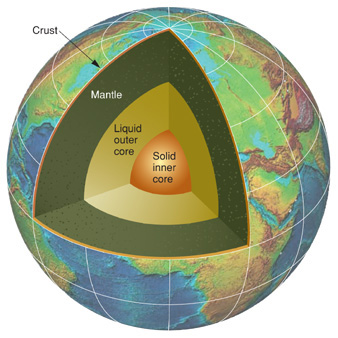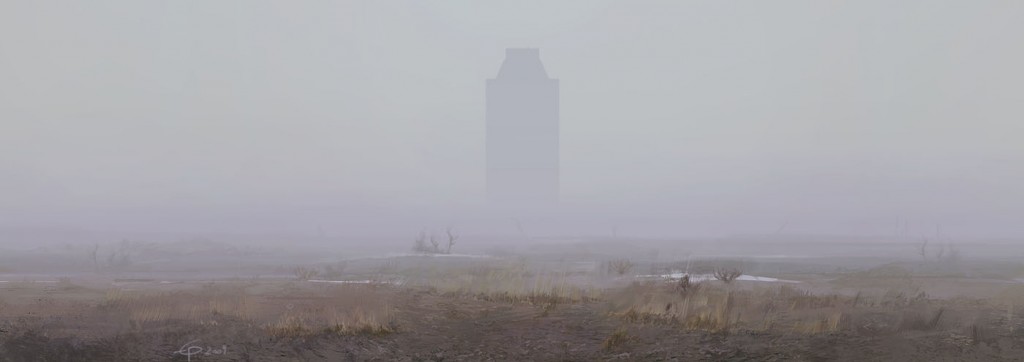In 1864 Jules Verne wrote Journey to the Centre of the Earth. Informed by new discoveries about the geology and the age of the earth, the novel attempted to equate levels underneath the surface of the earth with a hierarchy of older and older geologic time. Which is why the protagonists encounter Neanderthal men, and prehistoric animals, ultimately dinosaurs, as they go deeper and deeper into the earth. We know now that this is complete shit and really the centre of the earth is a solid ball of iron the size of the moon – possibly a single giant crystal – surrounded by a molten lake of liquid iron and nickel. Despite what we already know or can presume, scientists want to know more, and the latest idea is to start a nuclear fission reaction inside a big ball of radioactive cobalt, becoming so hot it literally burns through the crust and starts to sink towards the centre of the earth.
Most of what we know already about the earths core is comprised of theoretical modelling and real observation of the environment around us, even extending into space. For example, scientists can estimate the the type and quantity of elements that make up the solar system by analysing lightwaves coming from the sun and reflecting off other planets. The know from this the expected ratio of elements that make up the earth, but the samples we can physically access, from the earth’s crust, are low in iron. So its predicted that the rest of the earth, specifically the earth’s core, contains a lot of iron.
The study of seismic waves from earthquakes gives us other information. When an earthquake occurs, waves travel all over the world, both around the crust, along the surface of the earth, and also directly through the earth, which can be recorded and analysed on the other side. A certain type of wave doesn’t make it through certain parts of earth’s interior though, and these are the type of waves which don’t travel though liquid. So we know that part of the earth, the outer core, is made of liquid. More specifically, molten iron.
If the outer core is molten iron, the inner core can be considered frozen iron. Its not any cooler, but the increasing pressure of the earth raises the boiling point of iron, so that inner core is actually growing solid, collecting more and more iron from the liquid outer core, as the earth slowly ages. Theoretically, there must be an exchange barrier between the inner and outer core comprised of trace elements with melting points different to that of iron. This should function like a super slippery lubricant, allowing the inner core to rotate independently of the liquid iron around it. So its expected that the earth’s core rotates slower or faster than the earth itself, but no one knows for sure.
Above all this seemingly unstable collection of iron and trace metals is the mantle. We know a bit about what the mantle is made from, because bits of it spew up out of volcanoes every now and again. Its where stuff like diamonds, bits of carbon crushed into incredibly tight molecular structures, are made over the course of billions of years. The mantle is where the big shifts in temperature and pressure occur, the closer materials get to the core, and subsequently the mantle has lots of different layers with different compositions of various elements. The mantle is really the source of all the stuff that comprises the crust of the earth and, using techniques I don’t attempt to understand, geologists can tell from which part of the mantle the rocks we find on the surface of earth come from. They can even tell from which level of the mantle specific diamonds come from, based on the study of impurities they contain.
an illustration of Kola Superdeep Borehole by Egil Paulsen, looking across the Kola Peninsula
A full understanding of how the mantle is constructed, however, will require physical access. The deepest hole in the world, the 12 kilometre deep Kola Superdeep Borehole, dug by some Russian scientists, reaches no where near the mantle, but did go deep enough to prevent further drilling from the excessive heat of 180 degrees Celsius, and deep enough to inspire the hoax that they had drilled into the mythological Christian Hell. This was first reported by an evangelical news station in the United States in 1989, presented with a sound recording of the screams of the dammed, you can listen to it here, recorded with a “special heat-proof microphone” that was lowered into the hole.
Some Japanese scientists have been digging into the much thinner crust at the bottom of the ocean. They haven’t reached the mantle yet, but are choosing especially weak places to drill, where tectonic plates overlap, so as to study the occurrence of earthquakes. They even want to drill into the epicentre of the earthquake that caused the 2004 tsunami. This all sounds very counter intuitive to me, but if it leads to a better understanding of earthquakes and tsunami, or more Godzilla movies, I guess its for the best.
All of the above is pretty small scale compared to what’s coming though. In 2003 planetologist David Stevenson, of the California Institute of Technology, proposed to crack open the crust of the earth with the use of nuclear weapons and pour a probe covered in molten iron into it. The power of the blast, several megatons, and the weight of the molten iron required, between 100 000 tonnes and 10 000 000 tonnes, would make the crack self-propogate right down to the core. The probe would descend down this deepening crack while sending back data to the surface. That the nuclear explosion would be in the megaton range makes me guess he was probably joking, but some Russian and British scientists have improved on the basic idea and seriously proposed a variation.
In a series of papers, 2005’s Probing of the Interior Layers of the Earth with Self-Sinking Capsules, published in the journal Atomic Energy, followed by 2008’s Exploring the Earth’s Crust and Mantle Using Self-Descending, Radiation-Heated, Probes and Acoustic Emission Monitoring, published in the book Nuclear Waste Research: Siting, Technology and Treatment, the scientists propose the design of a probe built from radioactive cobalt surrounded by a tungsten wall. The intense heat from probe will cause it to literally melt into the earth, travelling slowly down through the crust and then mantle at the rate of about 20 kilometres per year. The cobalt will continue to generate radionuclides for several decades, allowing it to sink deeper and deeper. Although the probe is essentially dumb, just a collection of nuclear fuel with no technological devices, the probe can be tracked by equipment listening to the changes in the earth it creates as it sinks; the melting rock and its re-crystalisation in the wake of the probe.
This concept has a historical precedent. When Reactor no. 4 at Chernobyl had its catastrophic meltdown in 1986, there was a realistic concern that the exposed core would also literally melt in to the ground and start sinking down. Potentially this would made the disaster much worse, because there was an underground aquaduct below the reactor (used as a source of water coolant for the whole Chernobyl complex) and if the core came in contact with the water the resulting steam explosion would destroy the remaining three reactors above ground (which amazingly were still operating and continued to operate until the early 90’s.) Luckily this event was averted by having several helicopters fly over the reactor core and smother it in lead, clay, boron and canisters of liquid nitrogen. If the the threat of steam explosion was not present, would the reactor have been left to to burn its way down to the centre of the earth?
When I first told my girlfriend about this idea of melting a probe down into the centre of the earth, she exclaimed “kowai!”, meaning scary, a word the Japanese reserve for phenomena like atom bombs, tsunami and Godzilla. She asked, “Aren’t they afraid they will set off a chain reaction and explode the earth?” I am not a scientist and could hardly guess, but I teased her with the information that the earths core may also contains a fair amount of nuclear fuel, in the form of molten uranium, but that the scientists are willing to take the risk anyway.
More interesting to me, as a designer and not a scientist, is the difference the form of such a probe takes, when compared to space faring probes like Voyager, Huygens and Mariner. Those latter probes travel thousands of kilometeres to other planets and their moons carrying sophisticated cameras, sensors and other scientific probes, and transmitting back amazing pictures and data of their journeys. The cost millions if not billions of dollars and require the co-operation of the worlds best scientists and governments. Yet, to send something a few dozen kilometres or so into the centre of the earth, our best solution is dumb probe; a bundle of nuclear waste bunched together and set it on fire so we can watch it sink into the ground. By modern scientific standards, its like finding a dead body in the woods, poking it with a stick and calling that an autopsy.




